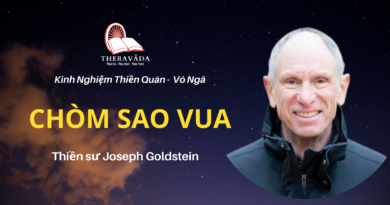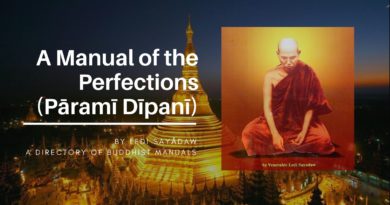NO INNER CORE – ANATTA: QUESTIONS AND ANSWERS
NO INNER CORE – ANATTA: QUESTIONS AND ANSWERS
Q: When you feel pain, you think that it is more permanent than thought. It is not permanent, but it does seem to be continuous.
– Yes, it seems to be continuous and to last for a long time, but actually the pain arises and disappears at every moment. Because we cannot see it arising every moment, we think that it is one solid thing. But when you practice meditation and keep noticing the pain, you will get concentration, and then you will come to see that there are gaps in that pain.
The same applies to sound, for example. If you note sound in your mind as it occurs, you will get concentration, and you will come to experience gaps in that sound: there is not really one continuous sound.
A person once told me about this level of concentration, which he achieved while he was meditating. Music was playing very loudly the whole night, so he could do nothing except concentrate on the sound by noting “hearing, hearing, hearing.” He then achieved concentration and experienced the music in small bits; in other words, he was able to detect gaps in what seemed to be one continuous sound. The elements of the music actually arise and disappear every moment; nothing is ever the same for even two tiny milliseconds.
Q: When I look at my own mental pain, I see a whole pattern of pain which; I interpret according to psychology, which I have studied. I think I have a pretty good knowledge of what it is, but is than an obstacle to seeing the nature of pain?
– All that is needed to see the nature of pain is to dwell with awareness on it, to make mental notes of it, and when you get enough concentration, you will penetrate into the nature of pain and see that it is impermanent.
Q: Even if I were to lose a lot of weight, cut my hair, and develop all new interests, others and myself would still know me as myself. Why is that, if there is no continuity?
– That continuity is created only in our minds. Actually, there is no continuity, but there is the relationship of cause and effect. Many people ask: ‘If there is no atman to go to different worlds, how do Buddhists say that we have past and future lives?’ The answer is that mental and physical phenomena arise and disappear at every moment. They arise, and then disappear, and in their place, other new phenomena arise. But the new phenomena that arise are not totally different or new because they have arisen due to some cause
Kamma causes the next life, and that next life is not totally new and different; neither is it the same or identical. The cause causes the effect to arise, and that effect is not the result of just any cause, but of a specific cause: a strong relationship exists between the cause and the effect. The cause can impart some of its similar Qualities to the effect, impart in the sense of causing certain qualities to arise.
In this way we have the notion of continuity but actually everything is newly arisen at every moment. There is a Buddhist formula describing rebirth: neither that person nor another. This means a person is reborn in a future life, but that person is not the identical person who died here; neither is that person reborn as a totally new person.
The commentaries, such as Visuddhimagga, XVII, give some similies as examples. Suppose someone shouts into a cave. When the sound comes back, it is not the original sound, but without the original sound, there can be no echo. Or suppose one lights a candle from another candle. It cannot be said that the flame has transferred itself to another candle. The flame in the second candle is not the same as that in the first one, but it came into being with the help of the first candle. Similarly, a seal leaves an impression on paper. The impression is not the same as the original seal, but neither is it unrelated to it.
We Buddhists do not accept permanence, but we accept a connection as cause and effect. Cause and effect go on and on, even in this lifetime, from moment to moment. This gives a person the impression of continuity, the impression of being the same person continually. Cause and effect go on and on throughout the life span until old age and death.
But death is just a conventional term for the disappearance of a certain psychophysical life process. But actually we are dying and being reborn at every moment. Thoughts likewise die and come into being at every moment, as do physical properties. Thus, even when we are living as we do now, we are dying, but we do not call it dying. We call it dying only when we come to the end of one life. Immediately after the end of this life, there is the next life. Immediately after death, there is rebirth; there is no interim between death and rebirth.
Think of the midnight hour of the previous day only one second after that, we call it a new day the next day. Actually time is just going on and on. One moment we call Sunday, and the next moment we call Monday. Similarly life and death and rebirth go on continually.”
Q: How does rebirth cease?
It ceases only when a person cuts off the root of this process. The roots are lobha (attachment), dosa (anger) and moha (ignorance). The Arahants have cut off this process altogether so for them, no future rebirth occurs. They have no desire for the life-death process to continue. It is like a lamp: when the oil is used up, the flame just disappears. Desire is like the oil; when desire is cut off there is no new becoming.
Q: But why does not an Arahant disappear at the moment of enlightenment?”
That is because the present life, by which I mean the present body and mind, is the result of past kamma. Past kamma gives rise to this present life, and it must run its course. The Arahant does not acquire new kamma, but past kamma must have its effect.
Anattalakkhana Sutta
Thus have I heard: The Exalted One was at one time residing at Benares in the Deer Park at Isipatana. There the Exalted One addressed the group of five monks saying: “Monks,” and they replied to Him, “Venerable Sir”
Then the Exalted One said:
“Form (rupa or matter) is not soul (anatta). If form, monks, were soul, then this form would not lead to affliction, and one would be able to say, ‘Let my form be thus. Let my form not be thus.’ But since form is not soul, so it leads to affliction, and no one can say ‘Let my form be thus. Let my form be not thus.”
“Feeling (vedana) is not soul. If feeling, monks, were soul, then this feeling would not lead to affliction, and one would be able to say, ‘Let my feeling be thus. Let my feeling not be thus.’ But since feeling is not soul, so it leads to affliction, and no one can say ‘Let my feeling be thus. Let my feeling not be thus.”
“Perception (sanna) is not soul. If perception, monks, were soul, then this perception would not lead to affliction, and one would be able to say, ‘Let my perception be thus. Let my perception not be thus.’ But since perception is not soul, so it leads to affliction, and no one can say, ‘Let my perception be thus. Let my perception not be thus.”
“Mental formations (sankharas) are not soul. If mental formations, monks, were soul, then these mental formations would not lead to affliction, and one would be able to say, ‘Let my mental formations be thus. Let my mental formations not be thus.’ But since mental formations are not soul, so they lead to affliction, and no one can say, ‘Let my mental formations be thus. Let my mental formations not be thus.”
“Consciousness (vinnana) is not soul. If consciousness, monks, were soul, then this consciousness would not lead to affliction, and one would be able to say ‘Let my consciousness be thus. Let my consciousness not be thus.’ But since consciousness is not soul, so it leads to affliction, and no one can say ‘Let my consciousness be thus. Let my consciousness not be thus.”
“Monks, what do you think? Is form permanent or impermanent?”
“Impermanent, Venerable Sir.”
“Now what is impermanent, is it unsatisfactory (dukkha) or satisfactory (sukha)?”
“Unsatisfactory Venerable Sir”
“Now what is impermanent, what is unsatisfactory, what is transitory – is it fit to be perceived thus: ‘This is mine; this is I; this is my soul’?”
“No, Venerable Sir”
“Monks, what do you think? Is feeling permanent or impermanent?”
“Impermanent, Venerable Sir”
“Now what is impermanent, is it unsatisfactory or satisfactory!”
“Unsatisfactory, Venerable Sir”
“Now what is impermanent, what is unsatisfactory what is transitory – is it fit to be regarded thus: ‘This is mine. This is I. This is my soul?”
“No, Venerable Sir”
“Monks, what do you think? Is perception permanent or impermanent?”
“Impermanent, Venerable Sir.”
“Now what is impermanent, is it unsatisfactory or satisfactory?”
“Unsatisfactory Venerable Sir “
“Now what is impermanent, what is unsatisfactory what is transitory – is it fit to be regarded thus: ‘This is mine. This is I. This is my soul?”
“No, Venerable Sir”
“Monks, what do you think? Are mental formations permanent or impermanent.”
“Impermanent, Venerable Sir “
“Now what is impermanent, is it unsatisfactory or satisfactory?”
“Unsatisfactory, Venerable Sir.”
“Now what is impermanent, what is unsatisfactory what is transitory – is it ft to be regarded thus: ‘This is mine. This is I. This is my soul”
“No, Venerable Sir.”
“Monks, what do you think? Is consciousness permanent or impermanent?”
“Impermanent, Venerable Sir “
“Now what is impermanent, is it unsatisfactory or satisfactory?”
“Unsatisfactory, Venerable Sir”
“Now what is impermanent, what is unsatisfactory, what is transitory is it fit to be regarded thus: ‘This is mine. This is I. This is my soul’?”
“No, Venerable Sir.”
“So, monks, whatever perception, whether past, future, or present: whether gross or subtle; whether in oneself or in others; whether inferior or superior; whether far or near; must with right understanding of things as they really are, be regarded thus:
‘This is not mine. This is not I. This is not my soul.”
“So, monks, whatever mental formations, whether past, future, or present; whether gross or subtle; whether in oneself or in others; whether inferior or superior; whether far or near; must, with right understanding of things as they really are. be regarded thus: ‘This is not mine. This is not I.
This is not my soul.”
“So, monks, whatever consciousness, whether past, future, or present; whether gross or subtle; whether in oneself or in others; whether inferior or superior: whether far or near; must, with right understanding of things as they really are, be regarded thus: ‘This is not mine. This is not I. This is not my soul. “
“Seeing thus, monks, the learned disciple of the Noble Ones becomes weary of form, weary also of feelings, weary also of perception, weary also of mental formations, and weary also of consciousness. Being weary, he becomes detached; being detached, he becomes free; being free, the knowledge arises, ‘I am free.”
“And he knows, ‘Rebirth is no more; I have finished practising the life of purity; done is what should be done; of this there is no more beyond.”
This is what the Exalted One said. Delighted, the group of five monks rejoiced at the Exalted One’s words.
And while this discourse was being given, the minds of the group of five monks were liberated from defilements through clinging no more.









